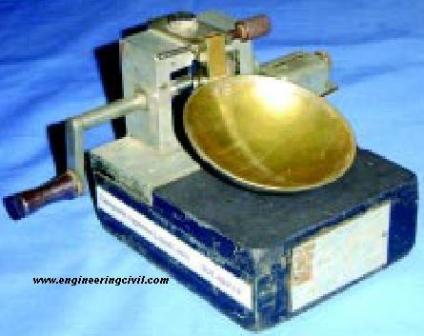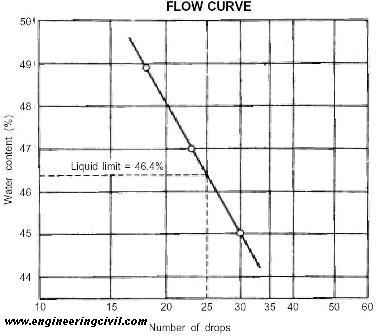This test is done to determine the liquid limit of soil as per IS: 2720 (Part 5) – 1985. The liquid limit of fine-grained soil is the water content at which soil behaves practically like a liquid, but has small shear
strength. It’s flow closes the groove in just 25 blows in Casagrande’s liquid limit device. The apparatus used :-
i) Casagrande’s liquid limit device
ii) Grooving tools of both standard and ASTM types
iii) Oven
iv) Evaporating dish
v) Spatula
vi) IS Sieve of size 425µm
vii) Weighing balance, with 0.01g accuracy
viii) Wash bottle
ix) Air-tight and non-corrodible container for determination of moisture content
PREPARATION OF SAMPLE
i) Air-dry the soil sample and break the clods. Remove the organic matter like tree roots, pieces of bark, etc.
ii) About 100g of the specimen passing through 425µm IS Sieve is mixed thoroughly with distilled water in the evaporating dish and left for 24hrs. for soaking.

Procedure to Determine The Liquid Limit Of Soil
i) Place a portion of the paste in the cup of the liquid limit device.
ii) Level the mix so as to have a maximum depth of 1cm.
iii) Draw the grooving tool through the sample along the symmetrical axis of the cup, holding the tool perpendicular to the cup.
iv) For normal fine grained soil: The Casagrande’s tool is used to cut a groove 2mm wide at the bottom, 11mm wide at the top and 8mm deep.
v) For sandy soil: The ASTM tool is used to cut a groove 2mm wide at the bottom, 13.6mm wide at the top and 10mm deep.
vi) After the soil pat has been cut by a proper grooving tool, the handle is rotated at the rate of about 2 revolutions per second and the no. of blows counted, till the two parts of the soil sample come into contact for about 10mm length.
vii) Take about 10g of soil near the closed groove and determine its water content
viii) The soil of the cup is transferred to the dish containing the soil paste and mixed thoroughly after adding a little more water. Repeat the test.
ix) By altering the water content of the soil and repeating the foregoing operations, obtain at least 5 readings in the range of 15 to 35 blows. Don’t mix dry soil to change its consistency.
x) Liquid limit is determined by plotting a ‘flow curve’ on a semi-log graph, with no. of blows as abscissa (log scale) and the water content as ordinate and drawing the best straight line through the plotted points.
REPORTING OF RESULTS
Report the water content corresponding to 25 blows, read from the ‘flow curve’ as the liquid limit.
A sample ‘flow curve’ is given as

If you have a query, you can ask a question here.



it’s helpful
Good it is better than book…
really this site is very helpful for me …………thank you
good site for civil engineers.
its really osum site…nd helpfull also…..
Very useful site
thanks for giving ppt. its clear my doubt.
good site for civil engineers
how much water is to taken for this test for 100grms of soil specimen
first starts with 30ml
i need proper calculation and method
what do I write in the analysis of the liquid limit report ?
under what circumtances crasargrand groving tool and ASTM groving tools are used?
Casargrand tool is use when there is clayey soil and ASTM tool is use when there is sandy use for expt.
thanks, it is useful. i need the relation of LL and PL
Please how to record and calculate a slump test and its graph
why to consider 25 blows for finding liquid limit
actually we take 25 as a standard,but no of blows can vary between 14 to 34..
we ‘ve been taughted that the qt is more than 10g it around 40 or 50 g
my question is sandy have greater liquid limit or clay soil have greater liquid limit ????
Its interesting for civil engineering but why to choose 25
why distilled water is use in this expt than normal water?
Sir how to find out liquid and plastic limit of clayey soil ?